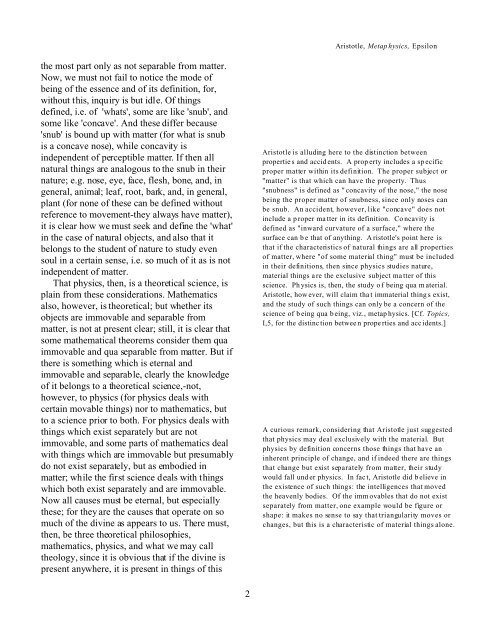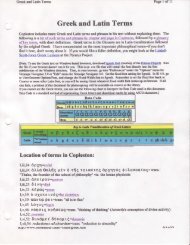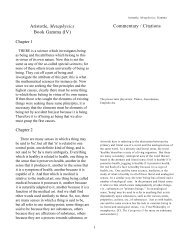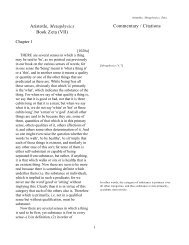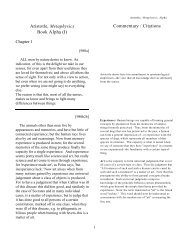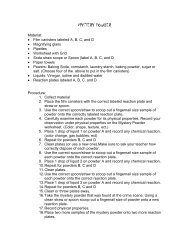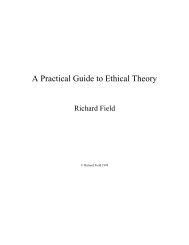Aristotle, Metaphysics Book Epsilon (VI) Commentary ... - CATpages
Aristotle, Metaphysics Book Epsilon (VI) Commentary ... - CATpages
Aristotle, Metaphysics Book Epsilon (VI) Commentary ... - CATpages
You also want an ePaper? Increase the reach of your titles
YUMPU automatically turns print PDFs into web optimized ePapers that Google loves.
<strong>Aristotle</strong>, <strong>Metaphysics</strong>, <strong>Epsilon</strong>the most part only as not separable from matter.Now, we must not fail to notice the mode ofbeing of the essence and of its definition, for,without this, inquiry is but idle. Of thingsdefined, i.e. of 'whats', some are like 'snub', andsome like 'concave'. And these differ because'snub' is bound up with matter (for what is snubis a concave nose), while concavity isindependent of perceptible matter. If then allnatural things are analogous to the snub in theirnature; e.g. nose, eye, face, flesh, bone, and, ingeneral, animal; leaf, root, bark, and, in general,plant (for none of these can be defined withoutreference to movement-they always have matter),it is clear how we must seek and define the 'what'in the case of natural objects, and also that itbelongs to the student of nature to study evensoul in a certain sense, i.e. so much of it as is notindependent of matter.That physics, then, is a theoretical science, isplain from these considerations. Mathematicsalso, however, is theoretical; but whether itsobjects are immovable and separable frommatter, is not at present clear; still, it is clear thatsome mathematical theorems consider them quaimmovable and qua separable from matter. But ifthere is something which is eternal andimmovable and separable, clearly the knowledgeof it belongs to a theoretical science,-not,however, to physics (for physics deals withcertain movable things) nor to mathematics, butto a science prior to both. For physics deals withthings which exist separately but are notimmovable, and some parts of mathematics dealwith things which are immovable but presumablydo not exist separately, but as embodied inmatter; while the first science deals with thingswhich both exist separately and are immovable.Now all causes must be eternal, but especiallythese; for they are the causes that operate on somuch of the divine as appears to us. There must,then, be three theoretical philosophies,mathematics, physics, and what we may calltheology, since it is obvious that if the divine ispresent anywhere, it is present in things of this<strong>Aristotle</strong> is alluding here to the distinction betweenproperties and accidents. A prop erty includes a sp ecificproper matter within its definition. The proper subject or"matter" is that which can have the property. Thus"snubness" is defined as "concavity of the nose," the nosebeing the proper matter of snubness, since only noses canbe snub. An accident, however, like "concave" does notinclude a proper matter in its definition. Co ncavity isdefined as "inward curvature of a surface," where thesurface can b e that of anything. A ristotle's point here isthat if the characteristics of natural things are all propertiesof matter, where "of some material thing" must be includedin their definitions, then since physics studies nature,material things are the exclusive subject matter of thisscience. Physics is, then, the study o f being qua m aterial.<strong>Aristotle</strong>, however, will claim that immaterial things exist,and the study of such things can only be a concern of thescience of being qua being, viz., metap hysics. [Cf. Topics,I,5, for the distinction between properties and accidents.]A curious remark, considering that <strong>Aristotle</strong> just suggestedthat physics may deal exclusively with the material. Butphysics by definition concerns those things that have aninherent principle of change, and if indeed there are thingsthat change but exist separately from matter, their studywould fall und er physics. In fact, <strong>Aristotle</strong> did believe inthe existence of such things: the intelligences that movedthe heavenly bodies. Of the immovables that do not existseparately from matter, one example would be figure orshape: it makes no sense to say that triangularity moves orchanges, but this is a characteristic of material things alone.2


